4 Days in Budapest: How to Plan A Perfect Budapest Itinerary
Budapest is one of our favorite cities in Europe. Straddling the Danube, the capital of Hungary is one of Europe’s most charming cities. Not only is it beautiful, but it is filled with history, culture, fun things to do, high quality and inexpensive wine (my personal favorite), and good food. The architecture is beautiful, the atmosphere is vibrant and there are plenty of things to do and see that are well worth the visit. The city is the perfect size: small enough to allow you to explore on foot, but big enough to offer plenty of activities over the course of 4 days in Budapest.
My mom’s side of the family is Hungarian, and before you ask, I speak exactly zero Hungarian, which is easily the hardest language I’ve ever tried to learn.
In this detailed guide, we will give you all the tips you need to create an unforgettable Budapest itinerary. We will take you through Hungarian history and culture and point out all the must-sees for someone visiting the city for the first time. We will also give you suggestions on where to eat, drink, and sleep.

While we have both visited Budapest multiple times including basically doing the exact itinerary below (twice), and my (Matt’s) mom’s side of the family is Hungarian, we’re by no means experts.
We wanted to bring you the best and most up-to-date recommendations, so we partnered with Diana Bernardo, who is a Portuguese travel writer who has lived in Budapest for the past three years. Over this time, she has hosted many friends and family members in Budapest, and has given them all an extensive tour of the city.
Now it’s your turn to get the insider tips she has to share that will help you plan an amazing Budapest adventure. Occasionally, we’ll interject with our thoughts and experiences, but for the most part, Diana is going to be your expert tour guide.
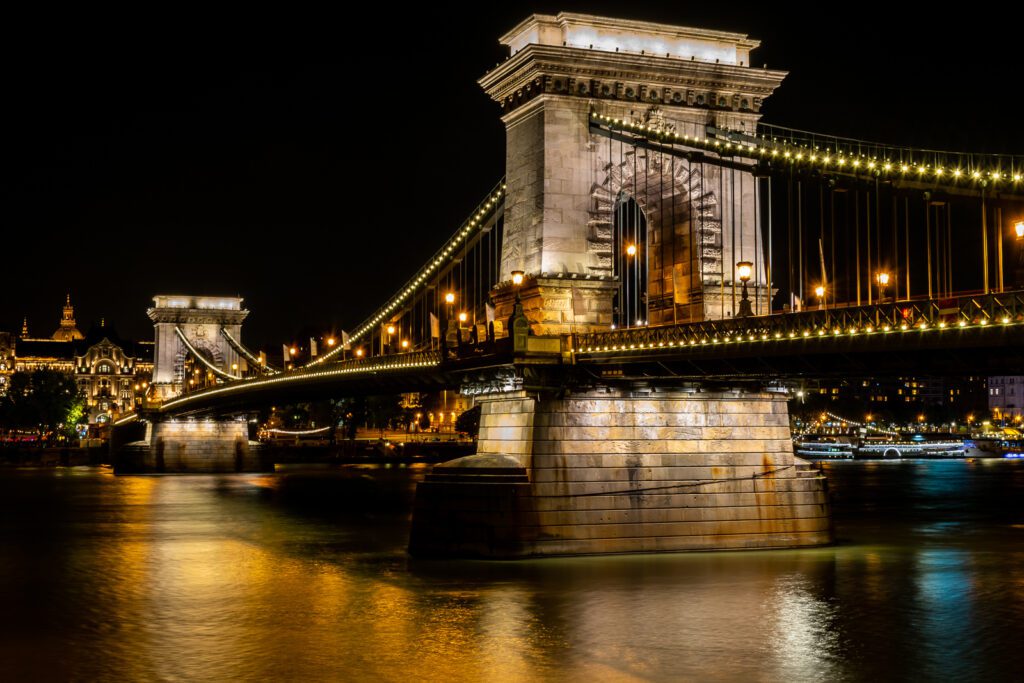
Disclaimer: Some of the links in this post, like hotel links, are affiliate links, meaning at no additional cost to you, we make a little bit of money if you click through and book. That being said, we would never recommend something to you that we don’t stand behind 100%.
Tips for Visiting Budapest
Even though Hungary is in the EU, the country didn’t adopt the Euro as a currency, and still uses the Hungarian forint. This means that there are plenty of exchange houses throughout the city, some better than others. Look for one that has a smaller gap between the buy and sell rates, that’s how you’ll make the most of your money.
Your best bet is to exchange money with your bank at home before you come, and to use ATM machines at reputable banks in Budapest (Budapest Bank and Erste Bank were the ones we saw most often). Keep in mind, you’ll likely be charged a flat fee by both your bank and the bank whose ATM you’re using, which means you should try to withdraw as much cash as you think you’ll need for your trip to avoid paying those flat fees multiple times.
Also, stay away from Euronet ATM machines, as they will give you a very unfavorable rate, and charge you a flat commission on top.
The best option would be to use a credit card with no foreign transaction fees. If you have an international card like Revolut or Wise, this is the best option. Card payments are accepted everywhere in the city, even for very small amounts, the only exception being some farmers markets or temporary selling stalls.
Where to Stay in Budapest
Budapest is divided into districts. The best one to stay at depends on your preference. If you want to be at the center of the action, close to everything, the 5th (Belváros) is the one for you.
It includes Deák Ference square, the main transportation hub in the center of Budapest, and it will give you easy access to any point of the city. It is also close to the nightlife area, without being too loud and boisterous.
Staying in Belváros (District V)
The 5th district is home to many of the city’s hotels and hostels. Here are a couple of options that we like for a range of styles and budgets.
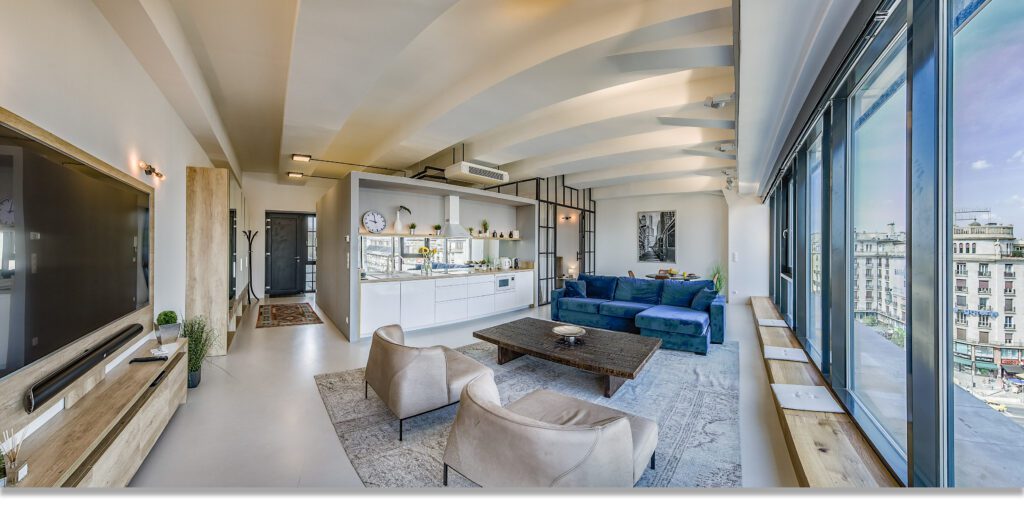
Loft Astoria: The location here couldn’t be better – it’s just a few blocks away from where we stayed on our last trip, which puts you within walking distance of most of Budapest’s main sights. It’s an apartment-hotel, so you’ll have a bit more room, kitchen facilities, and a range of room types from cozy studios (perfect for couples) to two bedroom apartments for larger groups. Unlike many of Budapest’s hotels, which are ornate and classically-decorated, the rooms here are ultra modern and sleek.
Wombats Hostel: We have stayed at Wombats during our trip to Munich, and it was great. Their Budapest outpost is super well located, at only 3 minutes walking from Deák Ference square, Wombat’s checks every box on our list for a good hostel. The rooms – a mix of dorms and private rooms – are good and include private bathroom, the breakfast is of high quality, the staff is nice, and the hostel provides many activities that you can take part in daily. Also, it used to be a four-star hotel that was converted to a hostel but kept the charm of the old building.
Pal’s Hostel: this is not a regular hostel but rather a combination of private rooms (some have shared bathrooms) and apartments around St Stephen’s square. They also offer both dorm beds, which are limited to four people each, which means no 24 bed dorms! In 2018, it won the award the Hostelworld’s award of the 10th best large hostel worldwide!
Staying in the Castle District (District I)
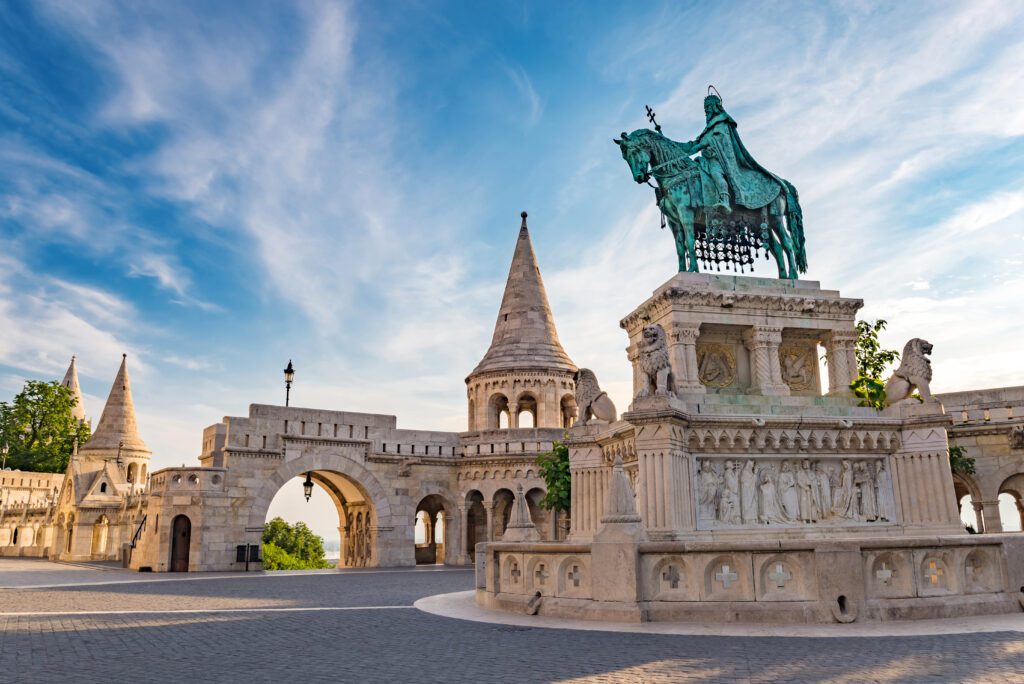
If you prefer a quieter neighborhood, with green areas and without the feeling of being in the middle of the city, we recommend the 1st, on Buda side.
It is also very well connected in terms of public transportation, and it even includes some landmarks of the city, like the Buda Castle and Fisherman’s Bastion.
In the 1st district, you won’t find many hostels, but rather hotels. This is the one we suggest:
PEST-BUDA Design Hotel: This small boutique hotel, in the heart of Buda, is full of charm. It is also very comfortable, providing the rest you deserve after a day exploring the city.
Buda + Pest = Budapest – A Geography Overview
Nowadays, Budapest is one of the biggest cities in Europe (although it really doesn’t feel like it when you are exploring), but that was not always the case. Originally, there were three independent towns: Óbuda, Buda and Pest. They all united in 1873, to form the city of Budapest.
Óbuda is adjacent to Buda, but Pest is located on the other side of the river Danube, which flows through the city, cutting it in half. This distinction is very used for referencing any spot in the city. The first thing you will need to know when going to a place is: is it in Buda or in Pest?
Also, the two areas have different vibes. Buda is quieter, more residential, hosting families and older generations. Pest has a more vibrant energy, shopping venues, and party spots.
It is extremely easy to go from one to the other, as Budapest has eight bridges connecting the two banks of the Danube.
4 Days in Budapest: a Complete 4-Day Itinerary
In the itinerary below, you’ll get a nice overview of the city, exploring a different part of Budapest on each day.
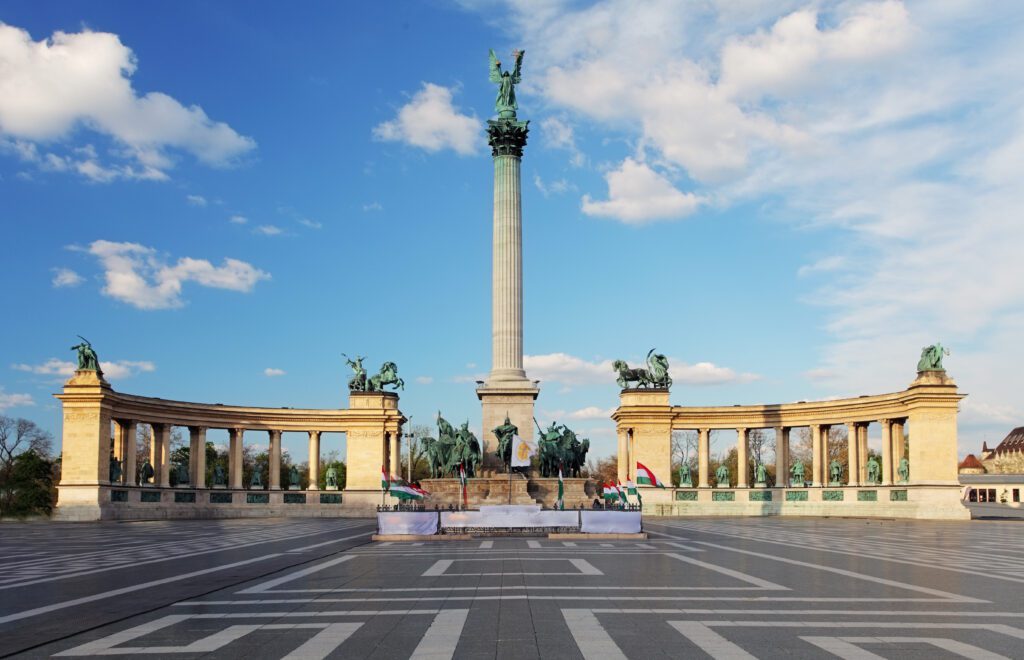
Day 1: Walking Tour, Castle District and Your First Thermal Bath
Your first day in Budapest will feel like a fairytale. You will go on a walking tour for an overview of the city, explore the picturesque Castle district and end up in a hot tub on a rooftop!
Morning: Walking Tour
As in any other city, the best way to start exploring Budapest is to do a free walking tour. This will give you an overview of the Hungarian history and culture, as well as a better understanding of where the major attraction points in the city are.
There are several tour options, but we recommend this one, as it covers a wide area and it finishes right where you will start your next visit, the Buda Castle.
Remember, these walking tours are tip-based, which is the way the guide makes money. Make sure to tip your guide at the end of the tour! We usually do $10 – $15 USD, but it’s up to you.
After a morning walking around, take a lunch break to recharge energies. Maja, with its daily changing menu, is a good option. Usually, it consists of a soup, a couple of options for main dishes, and a dessert, and it will cost you between $10 and $12. It is also 100% gluten free, so if you have Celiac disease you can eat there safely.
Afternoon: Castle District
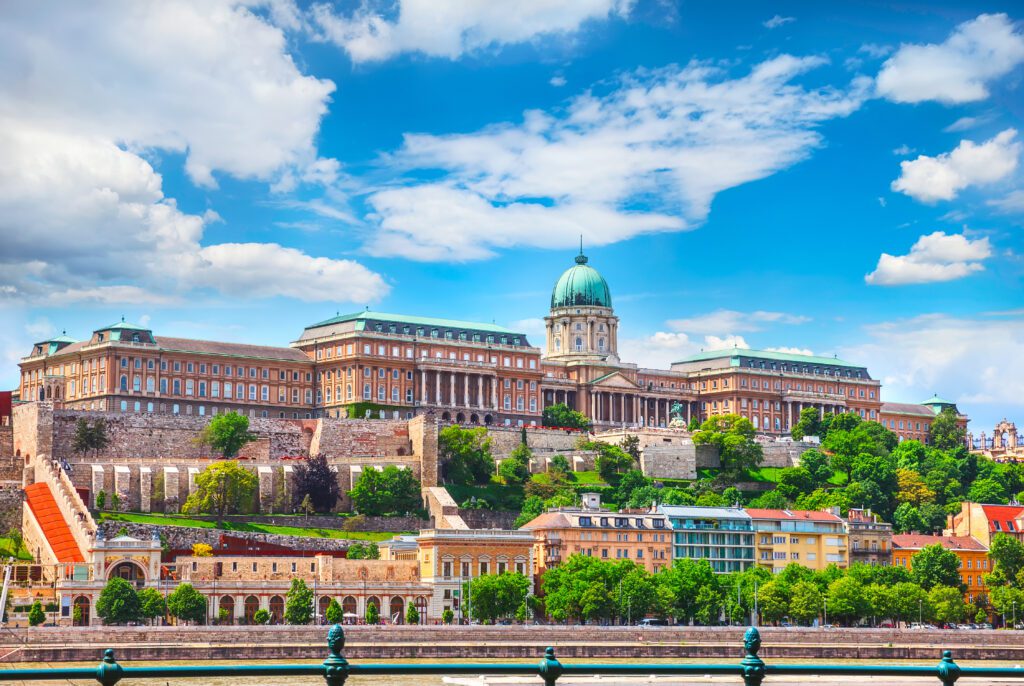
The Castle District is one of the loveliest places in the city. In a way, wandering through the streets makes you feel like you went back in time.
Start by checking the castle complex, which was once the residence of Hungarian kings but is now home to several museums and government institutions. There you can also see the changing of the guards, which happens every hour. The guards perform an interesting choreography, which lasts only a few minutes, but it’s worth checking out.
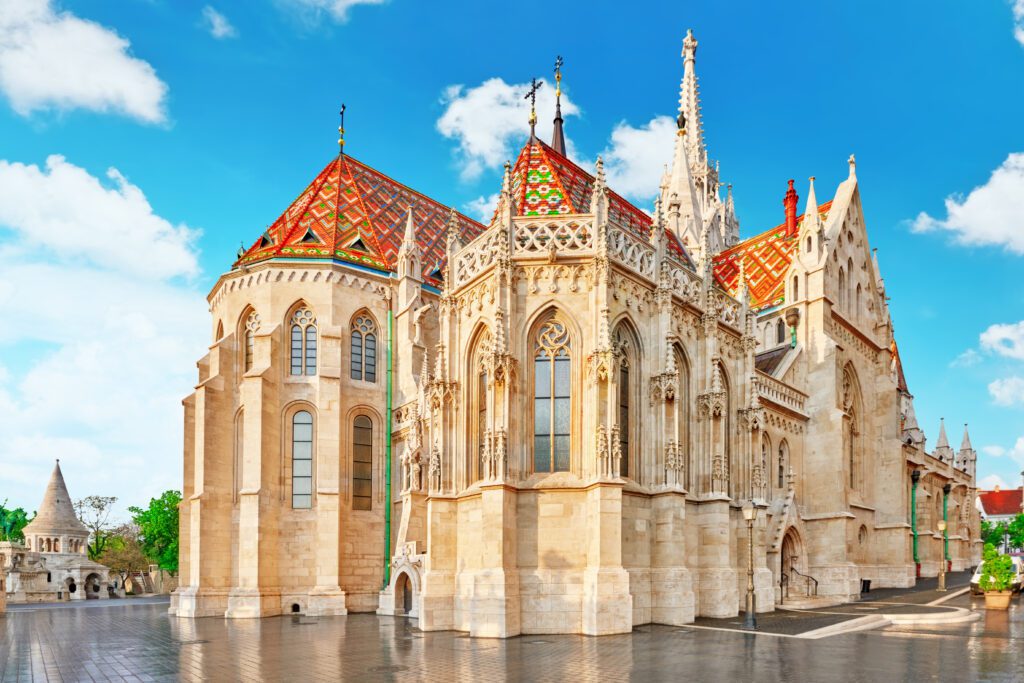
Just a few minutes’ walk from there, you will find Saint Matthias church, which was used as a coronation church by the Hungarian kings for centuries. Have a good look at its roof, with its unique tiles.
Last, but certainly not least, is our favorite place in this area – Fisherman’s Bastion. From there, you have an amazing view over the Danube and the Pest side of the city, including the Parliament building. This is also one of the most Instagramable spots in Budapest!
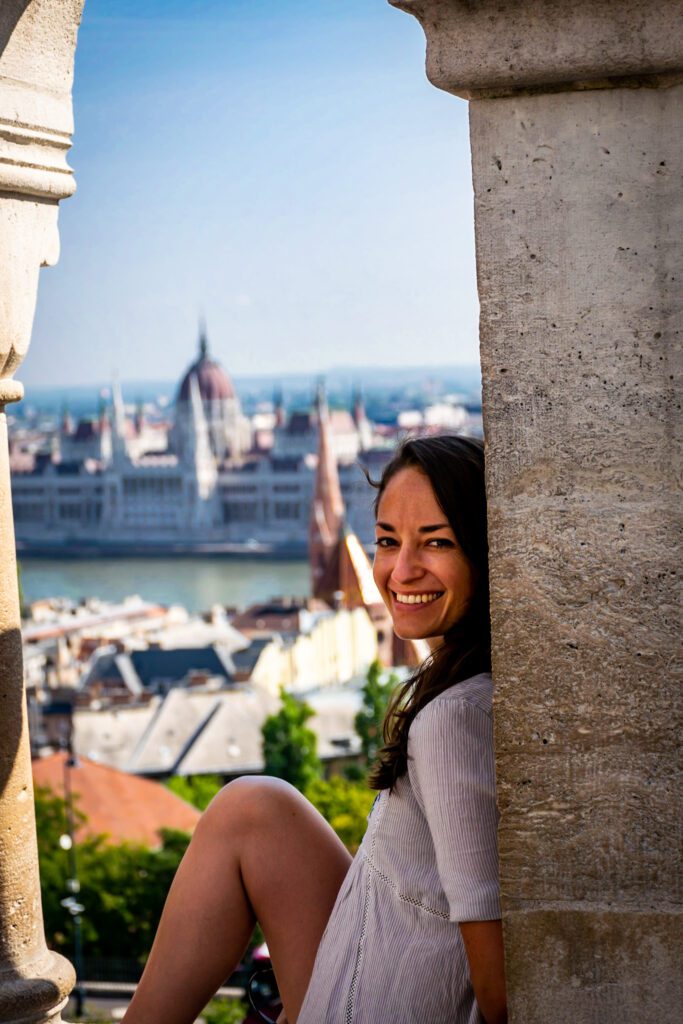
See? Look at those views. It’s even better after dark, and I highly recommend an evening stroll on the Buda side of the river to see it lit up after the sun goes down.
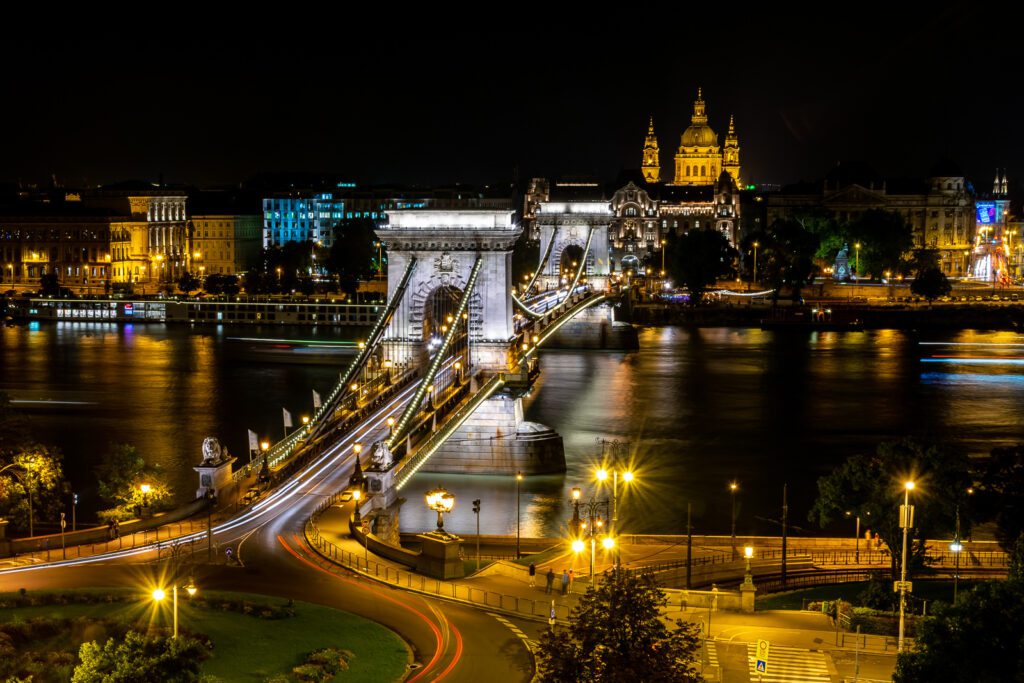
Evening: Rudas Thermal Bath
In the evening, enjoy one of Budapest’s most iconic attractions, the thermal baths. There are a dozen of them in the city, and they all provide quite unique experiences. The tradition of the baths dates back from when the Turkish occupied Hungary, and it remained to this day. Contributing to it is the fact that Budapest lies in the Carpathian Basin, where waters are full of medicinal properties.
Head to Rudas thermal bath, conveniently located at the bottom of Castle Hill. It dates back from the 16th century, and includes a swimming pool and six steam pools, at different temperatures. But the crown jewel is the open-air rooftop pool. From there, you can enjoy a magnificent view over the river and the city, while immersed in hot waters. This is definitely an experience that will make you feel like you are “living the life” – because you are!
After a couple of hours at the baths, you will probably feel so rested that the only thing you will want to do is to relax at your accommodation.
Day 2: Parliament, Margaret Island and Ruin Bars
Your second day in Budapest is full of Hungarian culture, from the sobriety of the Parliament to the incredible nightlife in the typical ruin bars. In between, a walk on Margaret Island, in the middle of the Danube.
Morning: Tram 2, Shoes on the Danube, the Parliament
Head to Fővám square, and hop on tram 2, that will take you along the Danube. On the other bank, you can see the Castle district, that you explored the day before, from a new angle. Get off at Kossuth Lajos tér, near the Hungarian Parliament.
Shoes on the Danube
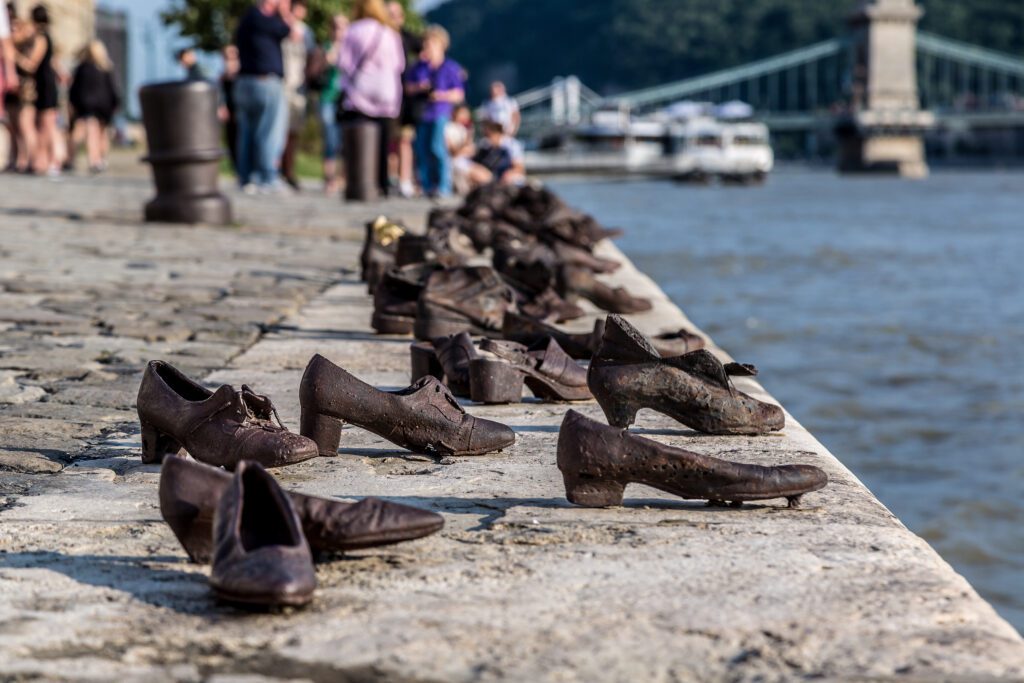
Before you head inside for a visit to the most iconic building in Budapest, go check the Shoes on the Danube. This memorial honors the Jews massacred in the Second World War, who were ordered to take off their shoes before they were shot, falling into the river.
Hungarian Parliament
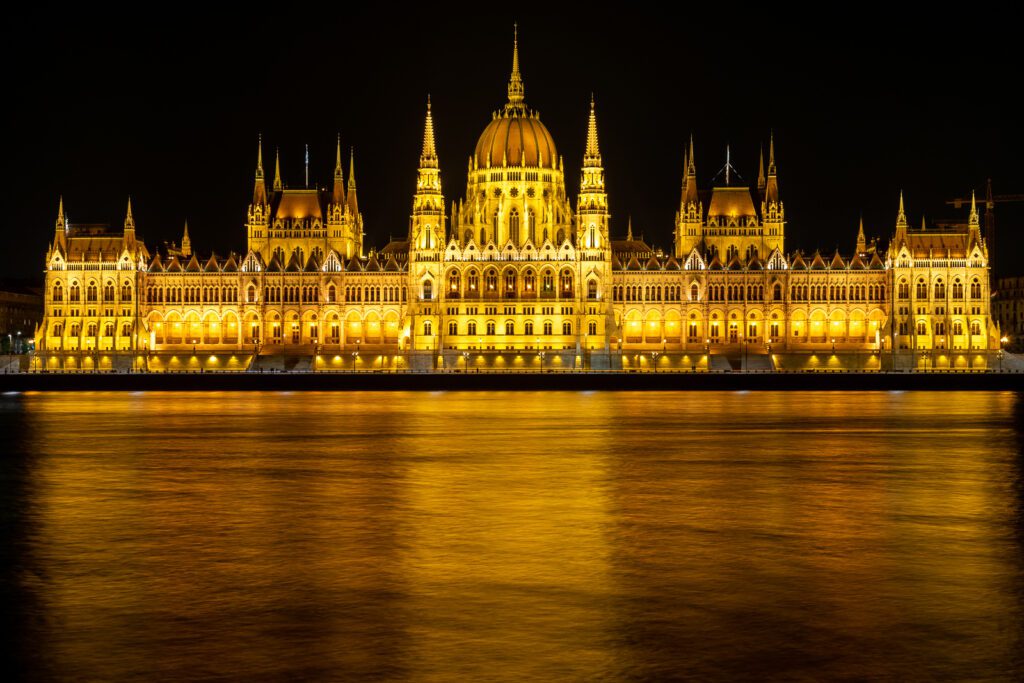
Next up is a tour of the Hungarian Parliament!
This is a very popular place, so make sure to book your tickets in advance. If you show up expecting to buy your ticket on the spot, you’re probably going to be out of luck. You can book them online, 3 or 4 days before.
After the visit, your stomach will probably be demanding a pause for food. Not too far, you find one of our favorite restaurants in the city, Drop. It is 100% gluten free, delicious and offers everything from a burger to the most typical of Hungarian dishes: the goulash.
Afternoon: Margaret Island
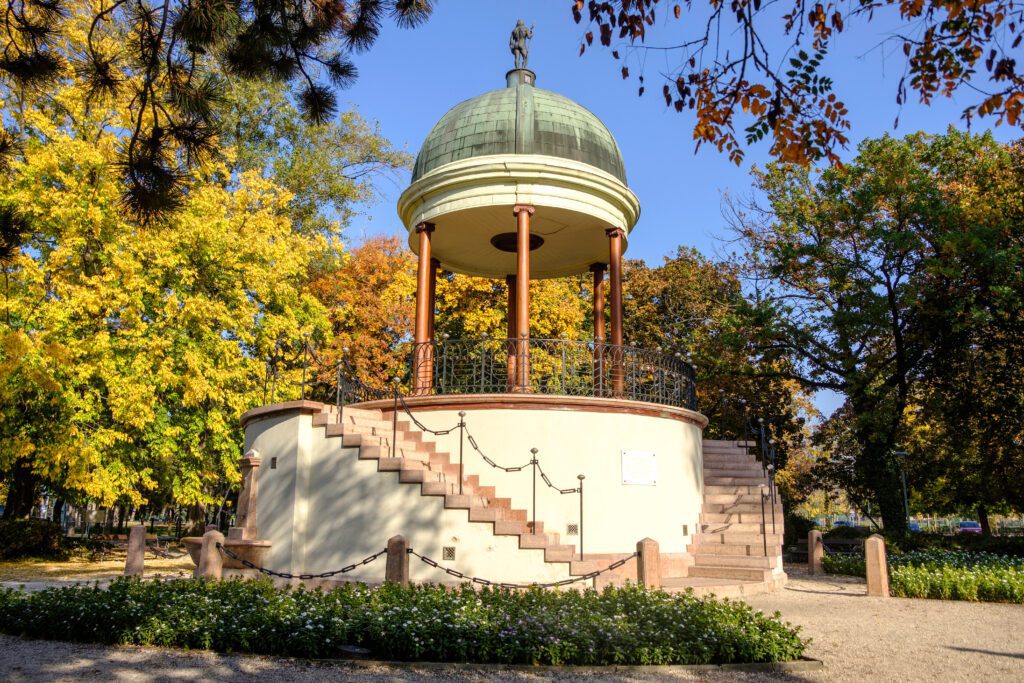
After a good lunch, the best way to burn some calories is by walking on Margaret Island.
This island of approximately 1.5 miles in length is located in the middle of the Danube, between Buda and Pest. It is a calm, green place in the middle of the city, where the locals spend time outdoors, walking, jogging, or having picnics. It is also home to a couple of interesting attractions, like a small farm and a musical fountain.
The sun is probably setting by now, so head to Buda side, not far from the island. There, you will have the front row to a beautiful event: the turning on the lights in the Parliament. As the sky gets darker and the building gets lighter, you will realize that, even though you already thought this was an imponent construction, it is even more so at night.
Evening: Budapest Nightlife, Ruin Bars
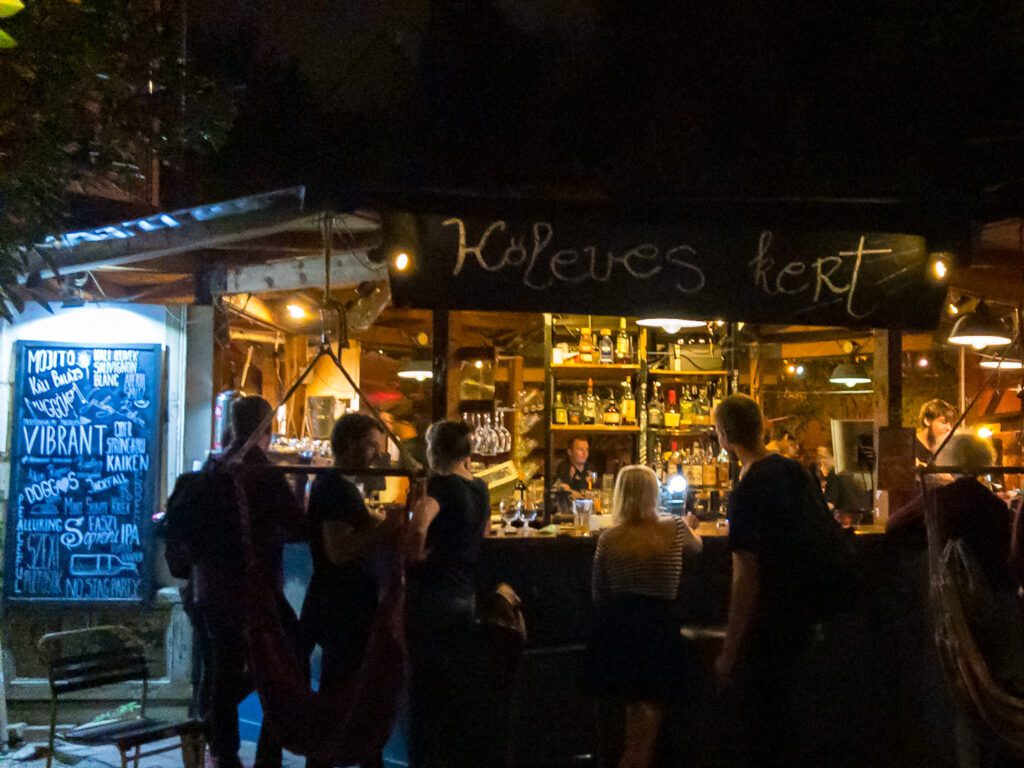
For dinner, we recommend Pata Negra Pest, a Spanish tapas restaurant with plenty of great gluten free options. If you are visiting during the high season, try booking in advance, as this is one of the most popular dinner places in the city. It’s especially lovely on warm summer evenings, when you can sit on the patio and do some good people watching. We liked it so much, we ate there twice.
When the sun goes down in Budapest, there is a place guaranteed to make sure you have a good time: the ruin bars. Mostly situated in the Jewish area, in the 7th district, these bars are an icon of the city. The mismatched decorations, the live music, the chill atmosphere, and the randomness of everything there make these bars a must-visit, even for those who don’t normally appreciate nightlife.
The Famous Ruin Bars in Budapest
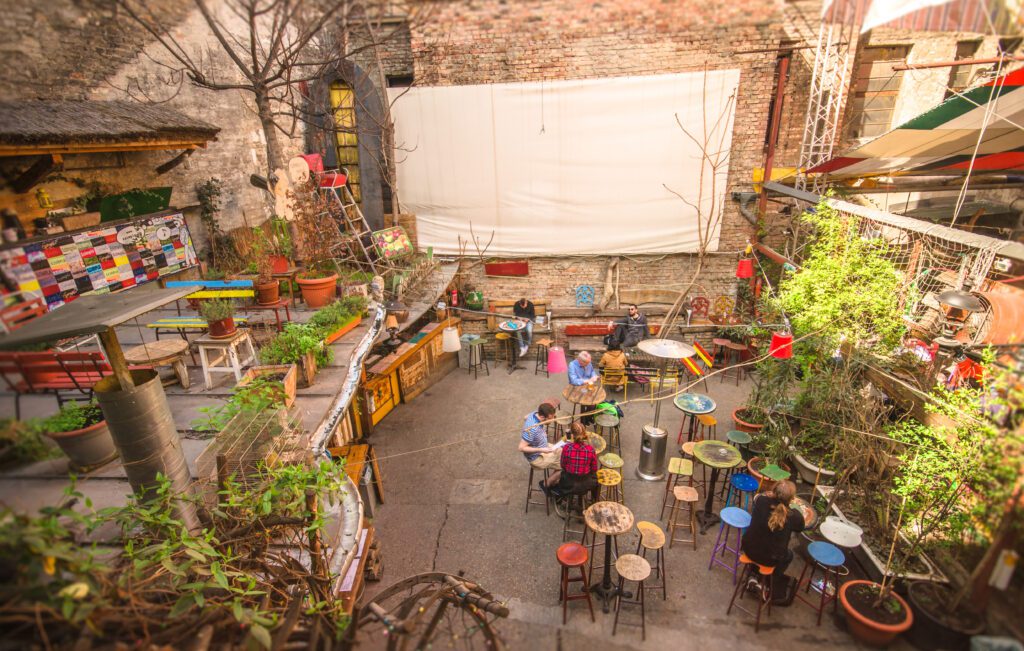
The most famous one – and the first to ever exist – is Szimpla Kert. Don‘t be scared by the line at the door, it usually moves fast. Inside, you will enjoy a bar that could also be considered a museum of the weirdness – curious?
The other one we recommend is Instant. Or should we say, “the other ones”? This bar is made up of many smaller bars, resulting in many different atmospheres, according to the room you are in. To give you an idea of how big it is, inside you will find a map of the place.
While enjoying the nightlife, make sure to try the most famous Hungarian drink, palinka. It’s a fruit brandy, with 40% to 70% of alcohol. Hungarians can get easily offended if you refuse their palinka offers while visiting them – there are very few things as engrained in Hungarian culture as this drink.
Day 3: Downtown Budapest, City Park, More Thermal Baths, and Wine Tasting
This is going to be an intense day! Starting with a visit to St. Stephen’s Basilica, moving on along Andrássy Avenue with a stop at the House of Terror, then reaching City Park where you will visit the most famous thermal baths in Budapest. Top off an amazing day with a delicious wine tasting session to explore the wide world of amazing Hungarian wine – which was a surprise to us!
Morning: Downtown Budapest
Start the day with a coffee at My Little Melbourne, whose slogan is “We love to make coffee for coffee lovers”. And we loved their coffee!
St. Stephen’s Basilica
Then, walk towards St. Stephen’s Basilica. Fun fact: it is 96 meters (315 ft.) high, exactly the same as the Parliament. The goal? Showing that both religion and legislators have equal power. Also, the number is not random, it evokes 896, the year the Kingdom of Hungary was established.
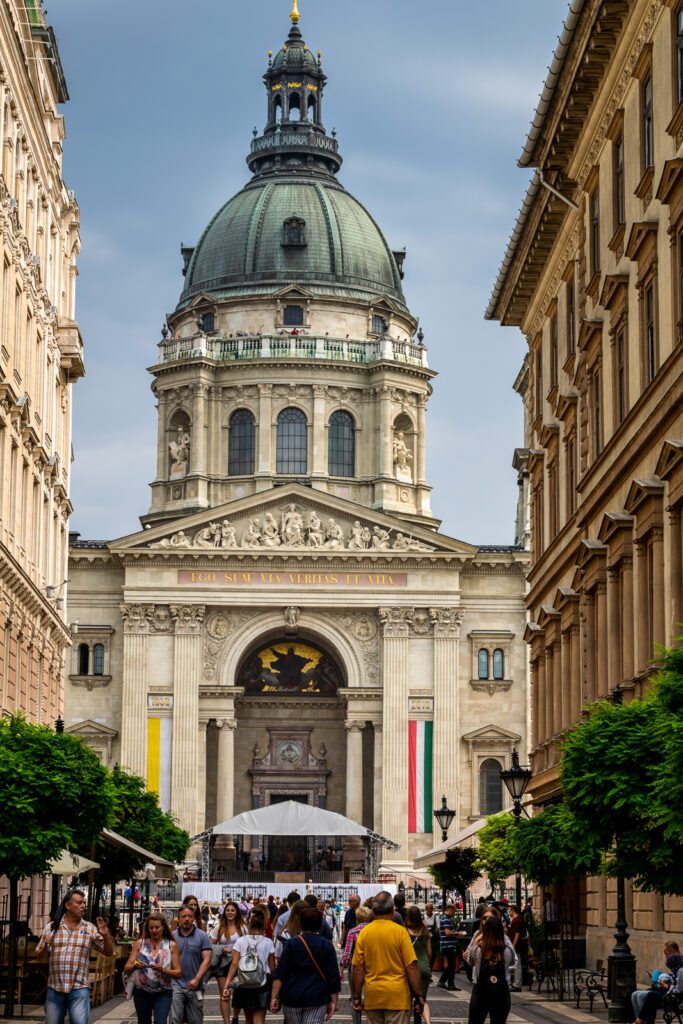
Luckily, there is an elevator that can take you up that high. For only $4, you can have one of the best views over the city, that shows you the urban tissue and lets you see as far as the Buda mountains.
Andrássy Avenue
Coming down, take a stroll on Andrássy Avenue. This could be considered the equivalent of the Champs Elysées in Paris but, let’s be honest, with a little less glamour. Still, definitely worth walking there.
On the way, you will find the House of Terror. It’s not a haunted house, but a museum that displays the terrors endured by the Hungarians during the fascist and communist regimes, throughout the 20th century. It takes you back to the 1950’s and see what Soviet occupation in Hungary was like, a history lesson that will give you a new point of view to understand Hungarian history and culture.
I highly recommend it – it’s my favorite museum in Budapest. It’s sobering, kind of like the Anne Frank House in Amsterdam.
Afternoon: City Park and Széchenyi Thermal Bath
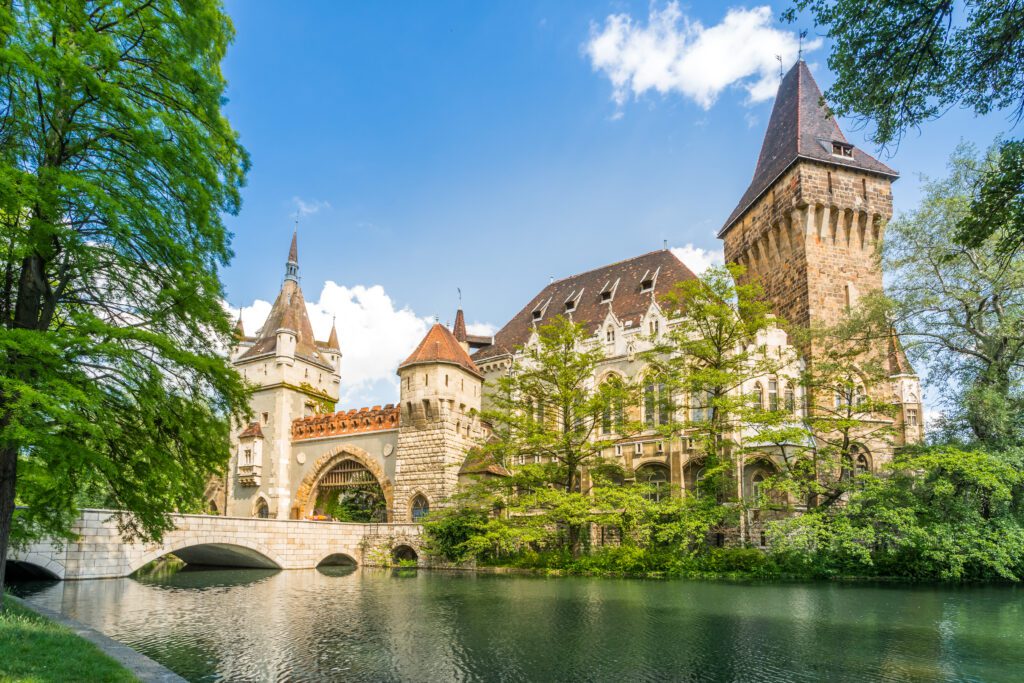
Now, it is a good time to try out the metro line 1 that we mentioned. Get off at Hősök Tere (Heroe’s Square), the entry to the City Park. Heroes Square is home to the towering monument in the middle of the plaza, called the Millennium Monument, which commemorates the Seven Chieftains of the Magyars who led the Hungarian people to the location in central Europe where they are today.
This green area is great to experience on foot. You should also check out Vajdahunyad Castle, located in the park. If you are lucky, there might be an event going on, as this is the venue where several festivals take place throughout the year.
Széchenyi thermal bath
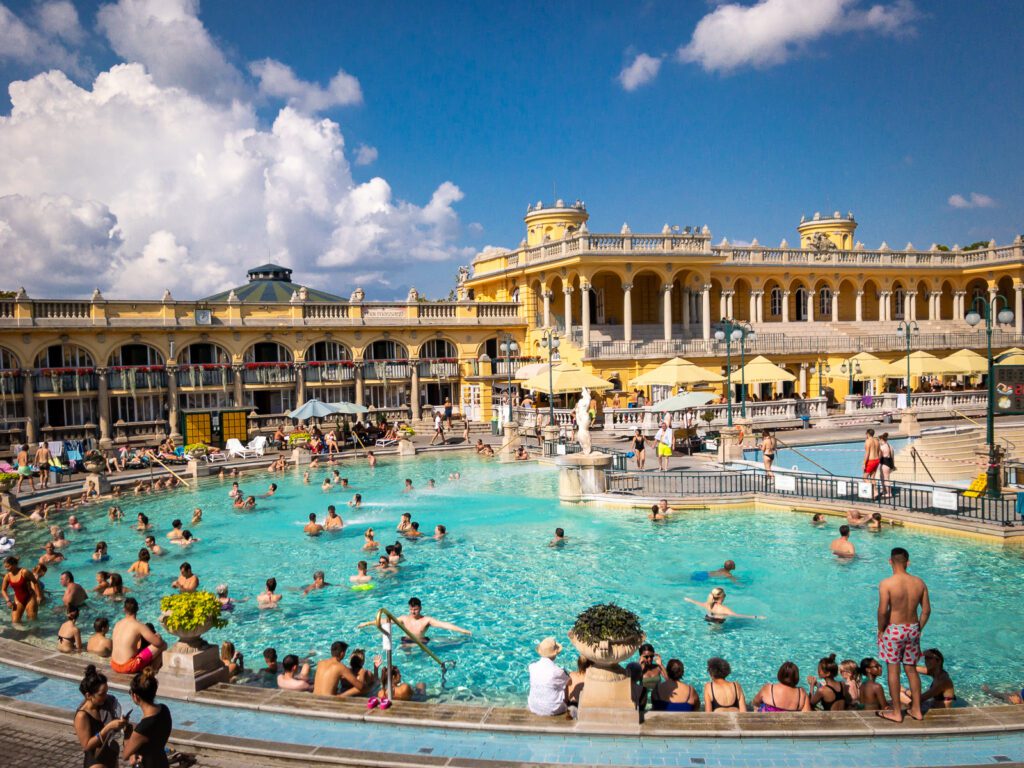
Then, on to one of the most interesting places in Budapest: the Széchenyi thermal baths!
Yes, we recommend trying out two different thermal baths in the city, that’s how great this experience is. However, if you only try one, then this is the one to try. It’s the most touristy of the many that you’ll find in Budapest, but for a good reason: it’s huge, and comprises both inside and outside pools, with different water temperatures.
The thermal baths are another must-have experience during your time in Budapest. They’re unlike anything I’ve ever experienced before. Especially on a cool, crisp day in the early fall, it’s invigorating and relaxing to sit back in the warm, mineral-rich water (don’t stay in for more than 20 minutes at a time!) and admire the amazing architecture around you.
After this, you might feel too relaxed to even want to drag yourself somewhere else. But how can you say no to wine?
Evening: Wine Tasting
For your last evening in Budapest, we suggest a wine tour. This one, more precisely, that we did on our trip and loved so much that, to this day, sometimes we still talk about one of the wines we tried.
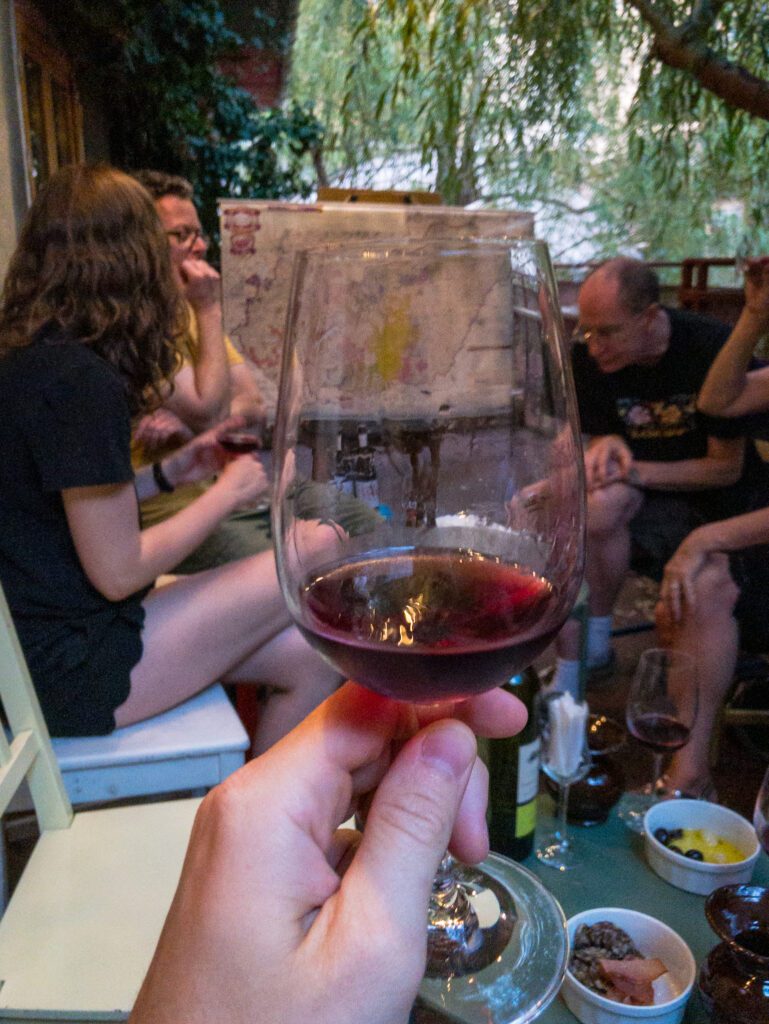
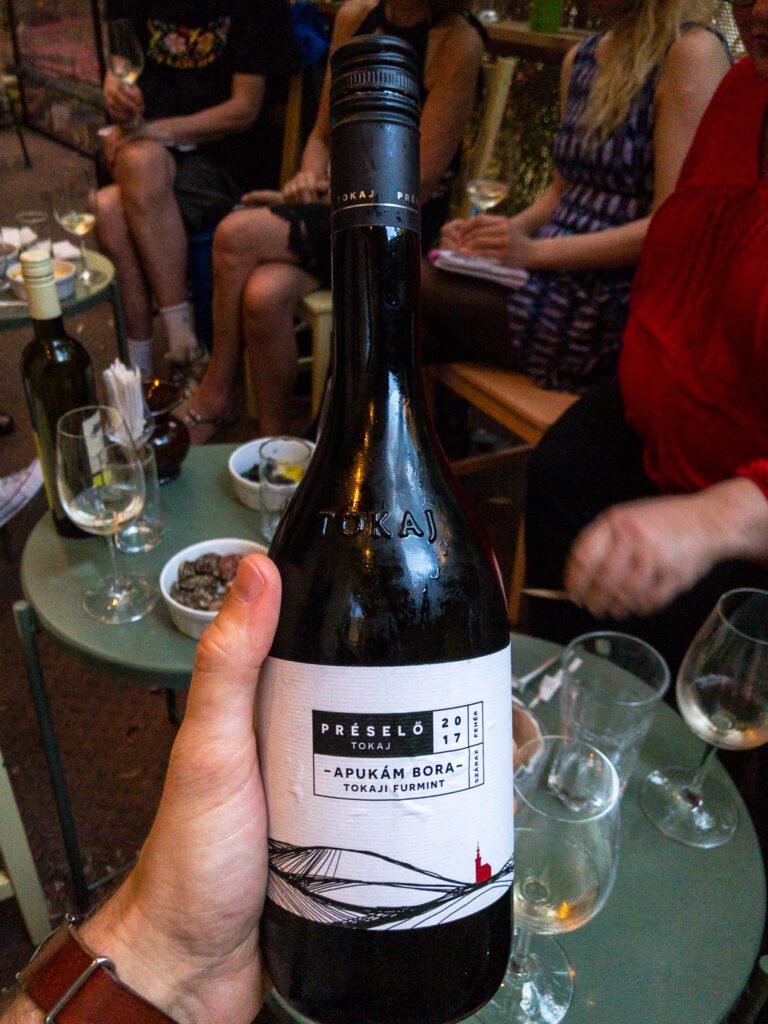
Even though it doesn’t get much recognition for it, Hungary is a wine country and has four main regions: Eger, Villány, Somló and Tokaj.
The latter is the most famous and its specialty is sweet wine. This also means that the wine in the country is relatively cheap, especially compared to the United States. The reason you’ve never heard of it is that only a small amount gets exported, and most of that is the super sweet variety from Tokaj.
This wine tasting class with Miki was a hidden gem and unexpected highlight for us, and I think it’s a must-do in Budapest.
Hungary has a ton of unique grape varietals, and the best rose that Alysha and I have ever had came from this wine tasting class – we still talk about it to this day.
You should probably not drink too much but well, if you do, your itinerary for the day is over anyway.
Day 4: Great Market Hall, Citadel and the Jewish District
On your last day, you will visit a traditional Hungarian market, climb up a hill for an amazing view of Budapest, and end up with a stroll around the Jewish District.
Morning: Great Market Hall and Citadel
To start your last day in Budapest, head to Váci street, a vibrant pedestrian area, with plenty of shops and restaurants. At number 74, almost in Fővám square, you will find a coffee shop perfect for your morning brew. Cafe Frei and is a Hungarian chain that offers coffees from all over the world, as well as some pastries, some of them gluten free.
The Great Market Hall
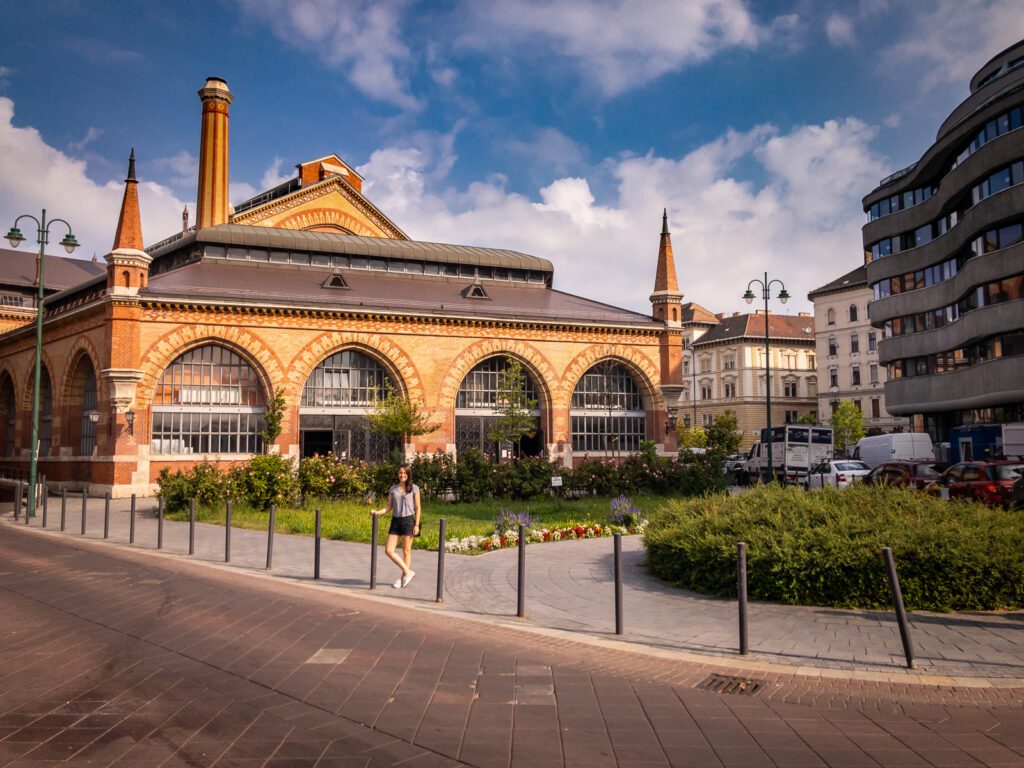
Nearby, you will see the hulking shape of Budapest’s fantastic Great Market Hall. On the ground floor, it is a traditional market, where you will find staple products in any Hungarian household: meats (including the traditional salami), vegetables and the most iconic item of Hungarian cuisine, the paprika!
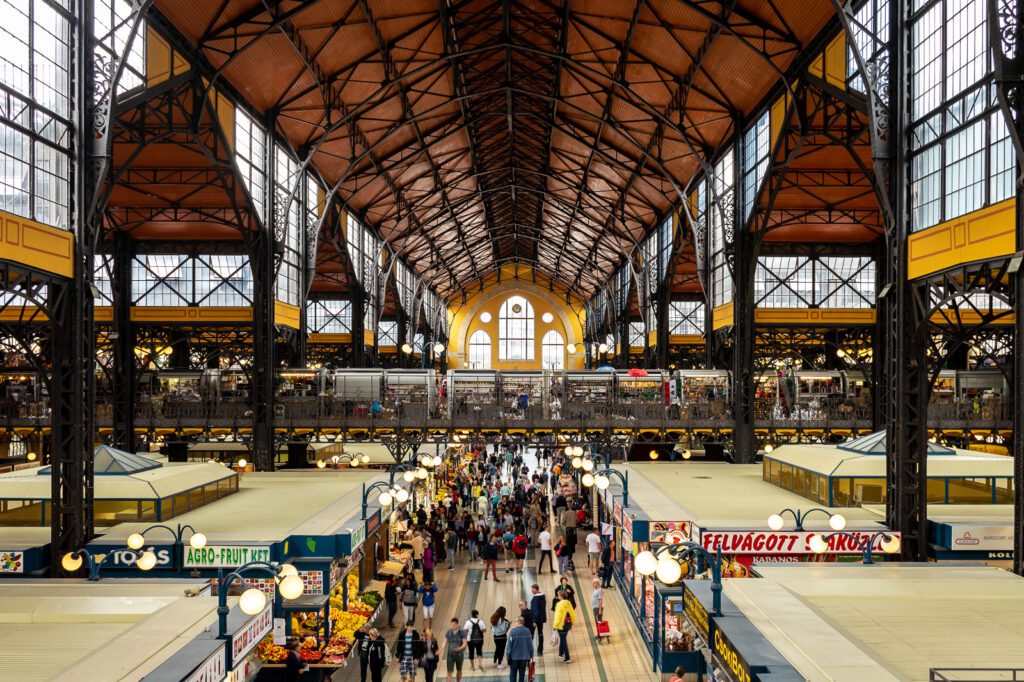
The second floor of the market is completely directed to the tourists. It offers handicraft and typical souvenirs, and some sales ladies are dressed up in traditional costumes. It is the perfect place to buy souvenirs for your loved ones.
Gellért Hill
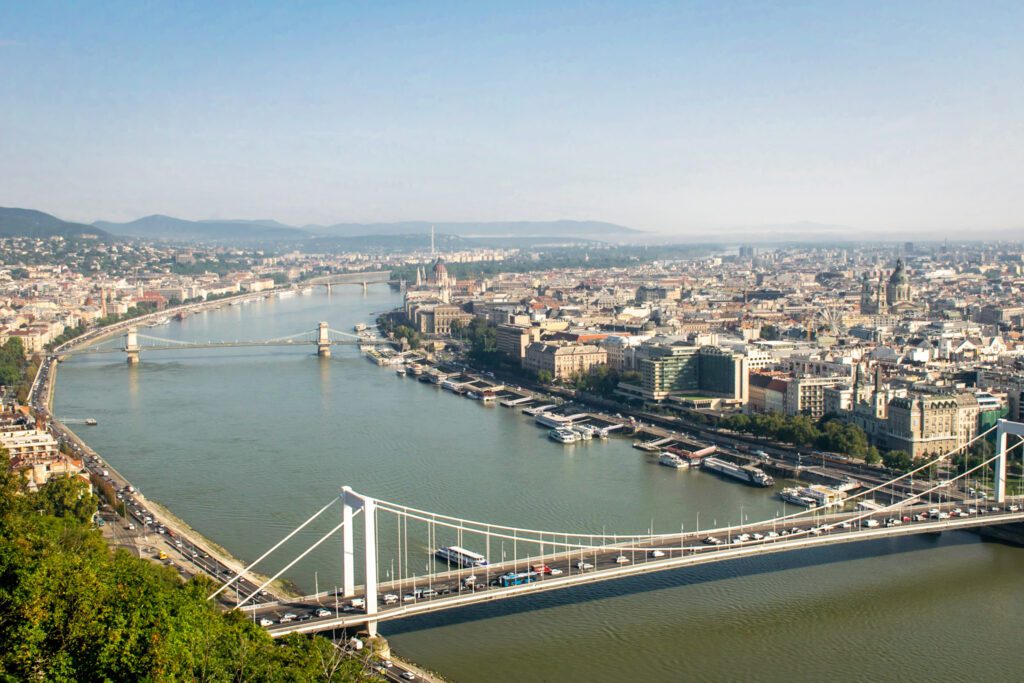
Up until now you might have realized that Budapest is a flat city. But there is a hill you should climb: Gellért.
Start at Szent Gellért square and go up until you reach the Citadel. On the way, pause on the several viewpoints that will give you an increasingly better view over the city, as you climb. Once you reach the top, you will be rewarded with the best view over Budapest!
Afternoon: Jewish District
For your last afternoon in the city, we recommend going back to the Jewish district to wander around. It has a different vibe during the day than in the night. It is full of quirky shops and cool cafes. We recommend a stop at Magvető Café, and a bite of their delicious gluten free walnut cake.
If you still have time, a visit to the Synagogue is well worth it. After all, it’s the biggest in Europe! There are guided tours every half an hour, included in the price of the ticket.
If You Have an Extra Day…
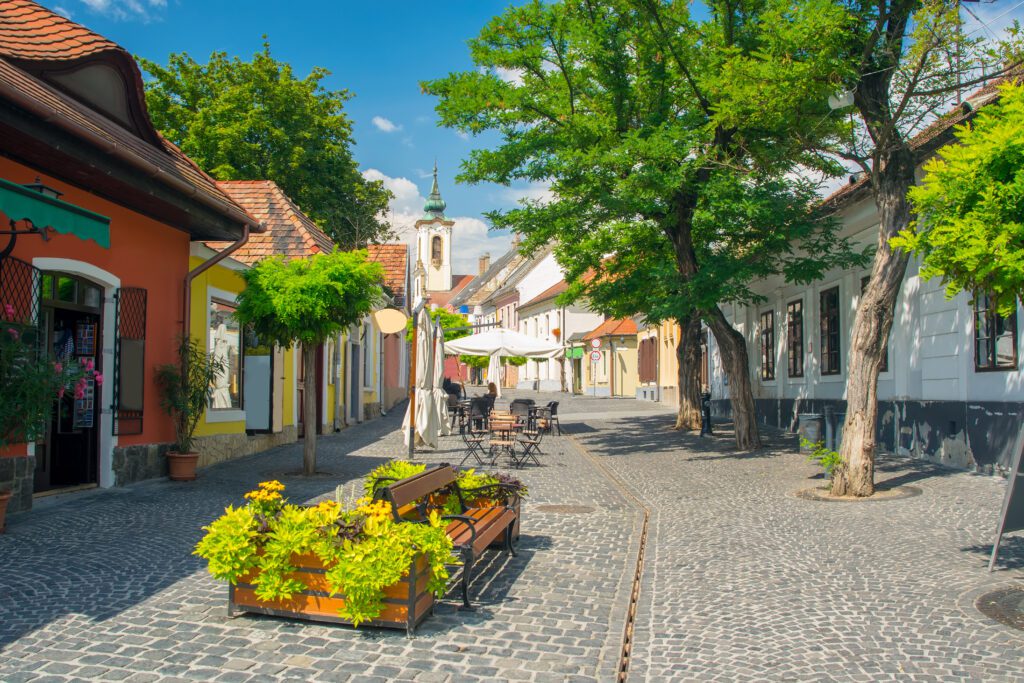
If you are lucky enough to have an extra day in Budapest, we recommend a day trip to Szentendre.
This picturesque village is accessible by train from Batthyány tér, and the journey takes around 40 minutes. Your weekly pass doesn’t cover this journey, so you should buy a ticket at the ticket office before boarding the train.
Once you get to Szentendre, you can explore the whole place on foot. Walking on the cobbled streets, you will see plenty of nice little cafes and restaurants, as well as decoration and souvenir shops. There is even a Christmas shop, where you can buy anything related to the holidays.
Szentendre lies along the Danube, so you can also enjoy some quiet time with a beautiful view sitting on the riverbanks.
For a delicious meal, try Palapa, a Mexican restaurant that offers a couple of gluten free options. It is so famous that if you mention to anyone in Budapest that you will go to Sztentendre, they will recommend this restaurant for sure.
Where to Eat and Drink in Budapest
Matt has Celiac Disease, which means he has to eat strictly gluten free or he’ll get VERY sick and ruin his vacation. If you’re eating gluten free and heading to Budapest, make sure to read our guide to gluten free Budapest.
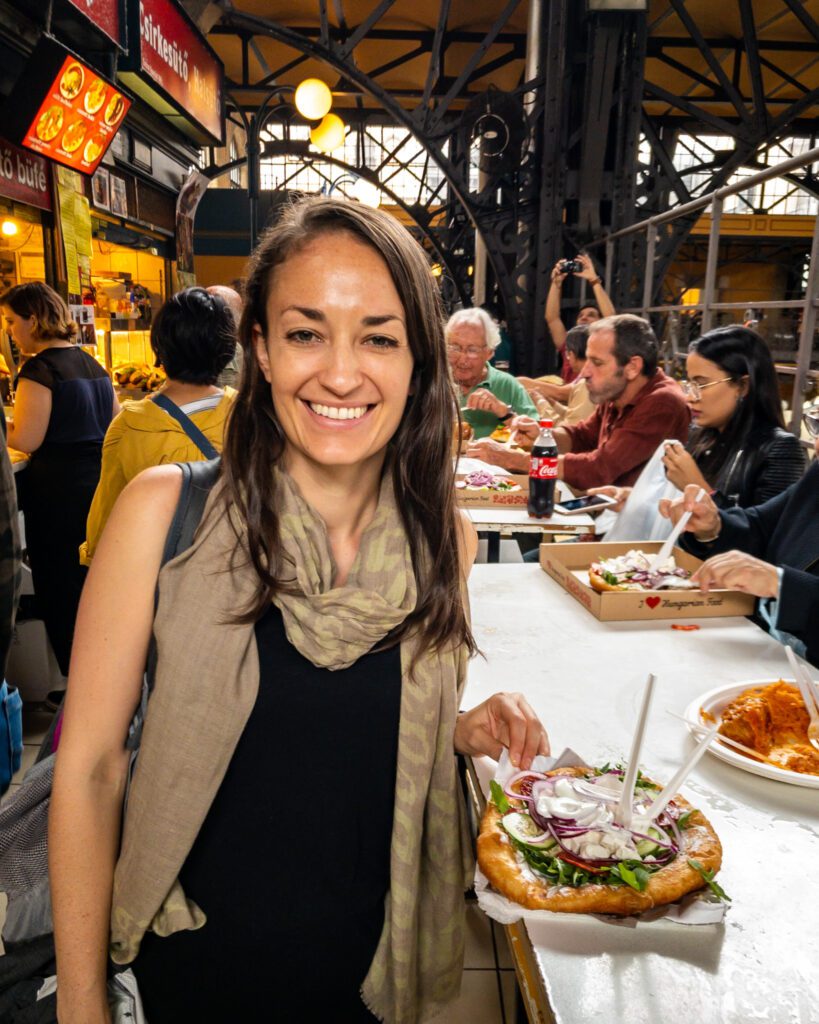
Eating in Budapest
- Drop – Our favorite restaurant in Budapest! The place looks great, the food tastes even greater. And it’s 100% gluten free.
- Maja – Offers a daily changing menu of delicious gluten free food for affordable prices.
- Cöli Bisztró – Little 100% gluten free cafe offering pizza, pastries and the traditional Hungarian “palacsinta” (pancake).
- Mazel Tov – Israeli food with a great atmosphere. Not a dedicated gluten free restaurant, but it has several gluten free options.
- Most burger places in the city have gluten free buns if you ask for it, even if not clearly stated on their menus. Some of the best are Las Vegan’s, Epic Burger and Burger Market.
Drinking in Budapest
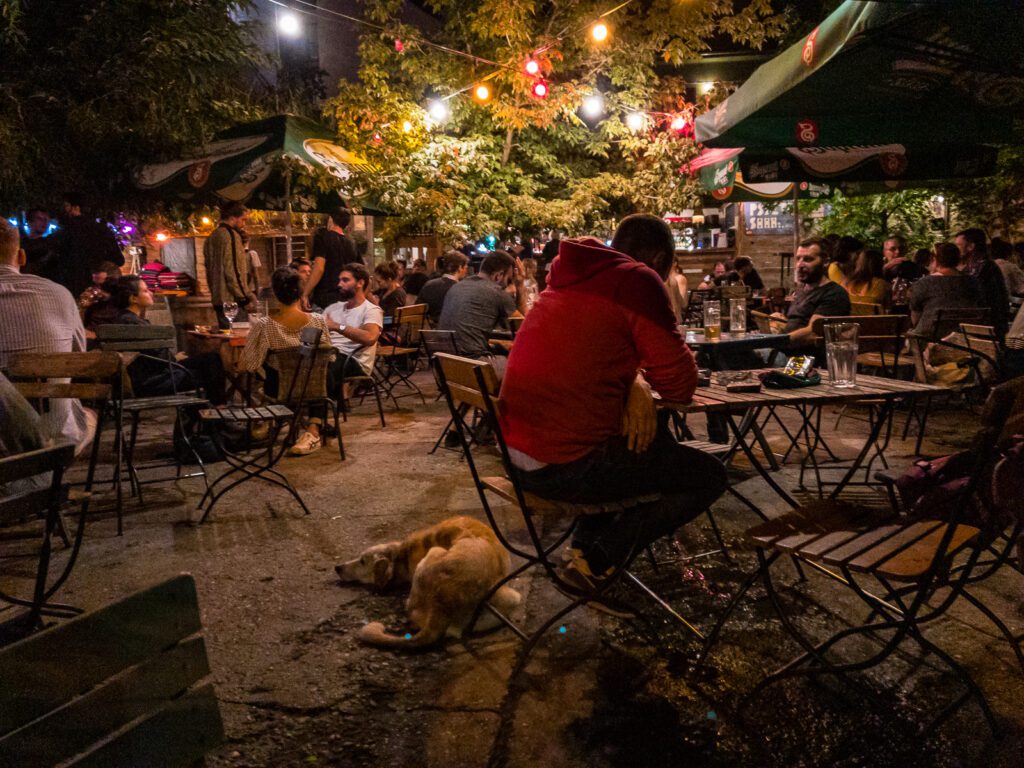
Budapest has a reputation of being the party capital of Europe. You know what that means…plenty of places to drink. Here are our top picks:
- Szimpla Kert – The first ruin bar in Budapest. Great atmosphere during the night, but also the perfect place for an afternoon drink, as it is open during the day and has some nice outdoor areas.
- Instant – Ruin bar to drink and party, one of the best nightlife places in the city.
- Kőleves Kert – Kert means Garden in Hungarian, so you can imagine what this bar is, a place with a nice outdoor area, where you can enjoy a wide variety of drinks.
- Akvárium Klub – A terrace right next to Deák Ferenc, in downtown, perfect for summer nights.
- St. Andrea Wine & Skybar – An elegant rooftop bar in the heart of Budapest. It belongs to the St. Andrea winery, from Eger, one of the most famous wine regions in the country.
- Doblo – A wine bar in the heart of the party district, offering more than 30 varieties of wine, in a cozy atmosphere.
When to Visit Budapest
Budapest has a continental weather, meaning that the winters are harsh, and the summers are hot, reaching temperatures around 100F. Still, if you don’t mind the heat, the summer is an amazing time to visit. The streets are full of life, there are plenty of events and an overall great energy across the city.
Spring (April to June) and Fall (September-October) are also good seasons to enjoy Budapest, with milder temperatures.
Winter is not the best time to visit because temperatures can drop to -20F and it gets dark around 3pm. However, if it is your only option, you will still find plenty of activities to do.
How to Get to Budapest
The best way to arrive in the Hungarian capital depends on your starting point. If you are in Central Europe, you can take a bus (Flixbus is the fastest and cheapest) or a train (check Trainline for times and prices) to reach Budapest in a matter of hours.
Otherwise, Budapest is served by the Liszt Ferenc airport. Located in the heart of Europe, this city benefits from flights connecting it to all the major European cities. Flights to the US are also available although you might need to transfer.
Once you land at the airport, reaching your accommodation is easy – considering you will, most likely, be staying at the city center. There is a bus, 100E, going straight from the airport to Deák Ferenc square, right at the heart of Budapest. The ticket costs $3 and the journey takes around 40 minutes. Buses depart every 20 minutes.
If you prefer the comfort of a taxi, be advised that Uber and Lyft do not operate in Hungary. The only app to call a taxi is Bolt. But you can also take a traditional taxi. You will see them right in front of the door when you exit the airport terminal. A 25-minute ride to the center should set you back around $25, and you can pay the driver in cash or card.
Getting Around Budapest
Budapest’s size makes it perfect to explore on foot. This will also allow you to explore the backstreets and hidden alleys that make this city a wonderful place in each corner you turn.
However, if you prefer to use public transportation, you are in luck! Central Budapest has one of the best transportation systems in Europe, including metro, bus and tram, some of which run all night.
In fact, even though we recommend exploring the city on foot, we strongly advise you to take metro line 1 or, as the Hungarians call it, “kisföldalatti” (“the small underground”). It is the oldest metro line in mainland Europe and the world’s second oldest, after the London Underground.
Except for some buses, you can not buy the travel tickets on board. You must purchase them beforehand on one of the many machines in the city, located at stations and stops. A single ticket costs around $1 but if you plan on using transports often during your visit, the best option is to get a weekly pass for $16, that gives you unlimited access. You can check the different types of tickets available on the BKK page.
How Many Days in Budapest?
In general, I always recommend spending more time in each city, rather than trying to fit in as many cities as possible and avoid the feeling of needing a vacation from your vacation.
Which begs the question, how many days should you spend in Budapest?
You will want plenty of time to see all the key sights, like the world-famous thermal baths, and still have time to wander the romantic cobblestone streets and relax at one of Budapest’s best coffee shops. The last thing you want to do is turn your Budapest itinerary into a whirlwind that makes you want a vacation from your vacation.
To answer your question of how many days in Budapest, my recommendation would be at least 3-4 days.
Well, it looks like you have a magical 4 day trip to Budapest ahead of you. I’m totally jealous – it’s one of my favorite cities in the world, and I would move there in an instant. I still might, in fact.
Between the beauty of the city, the rich culture and history, and the vibrant people, Budapest is one of the most underrated cities in Europe.
It is also one of the places where tourism has increased the most in the past few years. People are quickly realizing that Budapest might be, in fact, one of the best travel destinations in the world. I am sure you will understand why as soon as you set foot there.
About the Contributor: Diana Bernardo is a former journalist with an endless love for travel. She has been to 30+ countries in Europe and lived in 4 of them. She writes about her experiences and favorite destinations regularly on Medium and on her blog.

which exact location were u able to get the overview of the parliament building?was it buda hill?can u give me the direction?
Hey there! Which picture are you asking about? For the straight on view, it’s across the river right in front of Batthyány tér metro station. For the view from above with the Chain Bridge and Parliament, it’s from the railing just in front of the Buda Castle. This is the post where I discovered some of the photo spots: https://hungaryphototours.com/top-photography-spots-budapest/
Thank you for this wonderful guide! When I was in Budapest recently I googled ‘4 days in Budapest’ and fortunately for me your blog came up. While I didn’t make it through your whole list, it was a great overview. I particularly enjoyed the Rudas Thermal Baths and the wine tasting with Miki, which I wouldn’t have heard about elsewhere. Looking forward to reading more of your itineraries!
Heading to Budapest next week and this is golden! Thank you!!